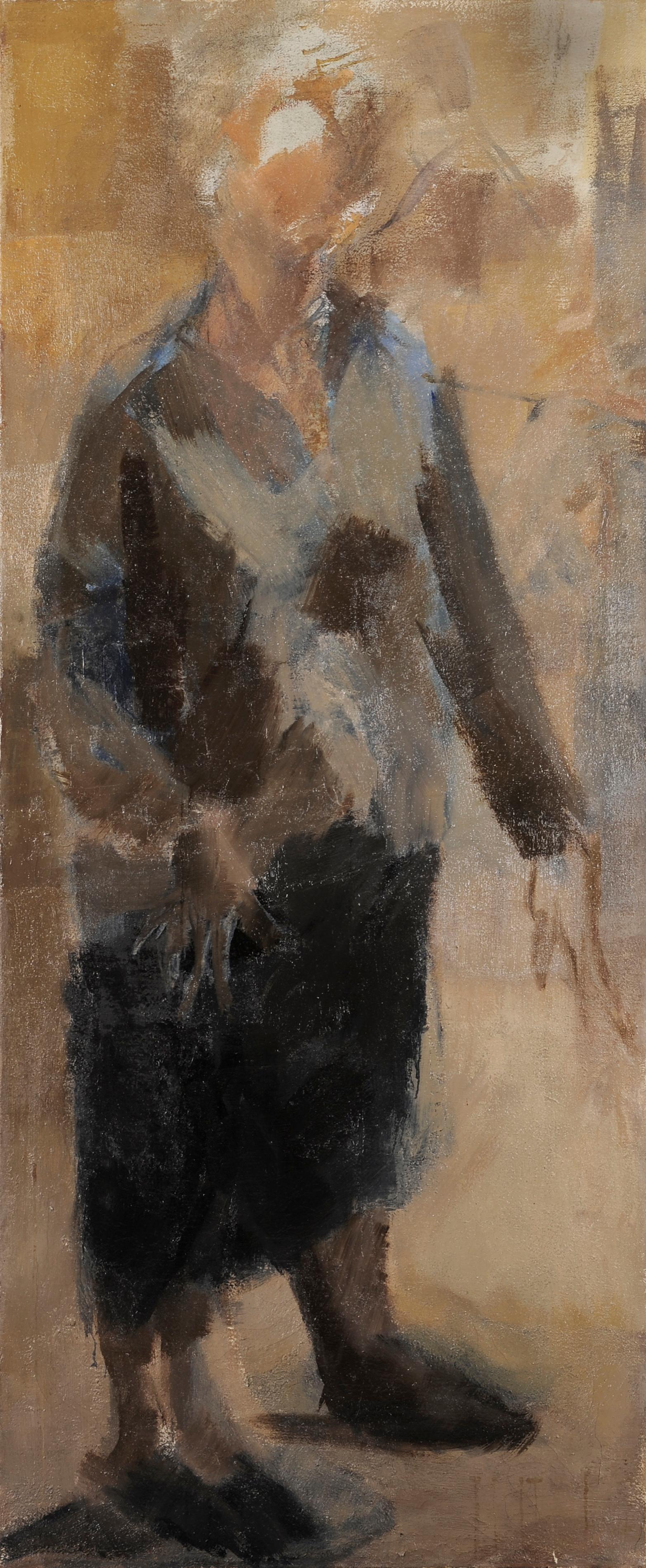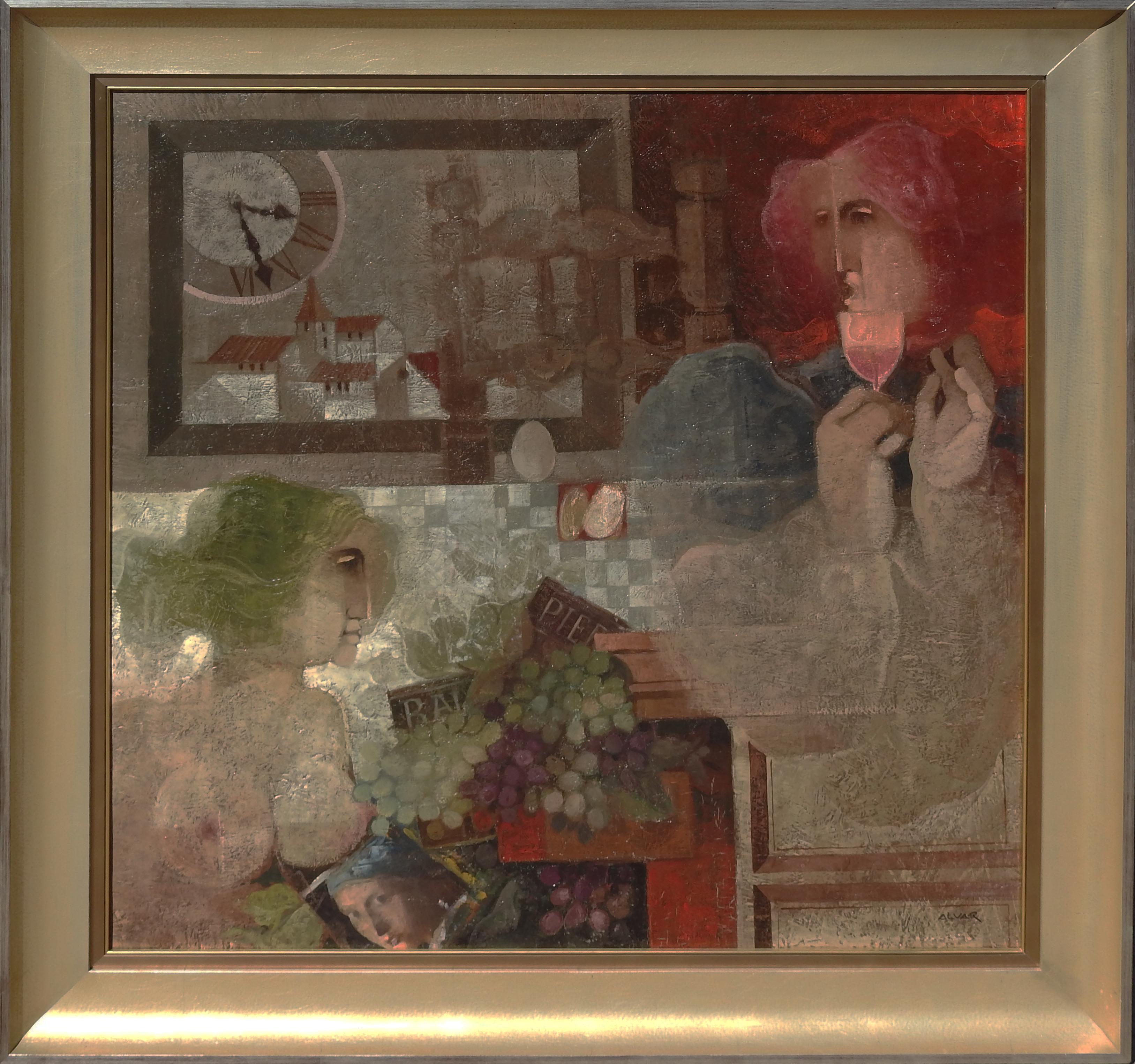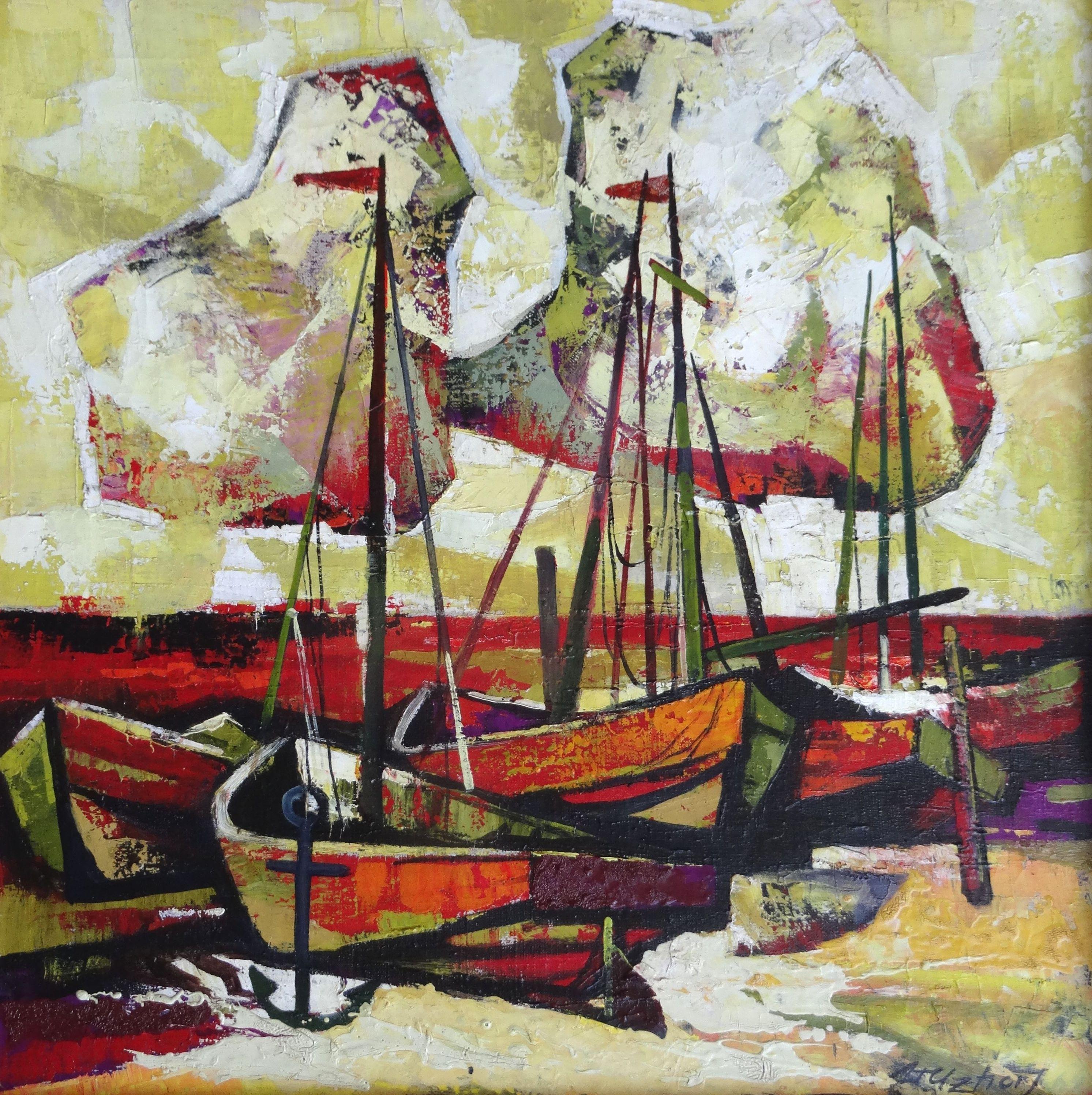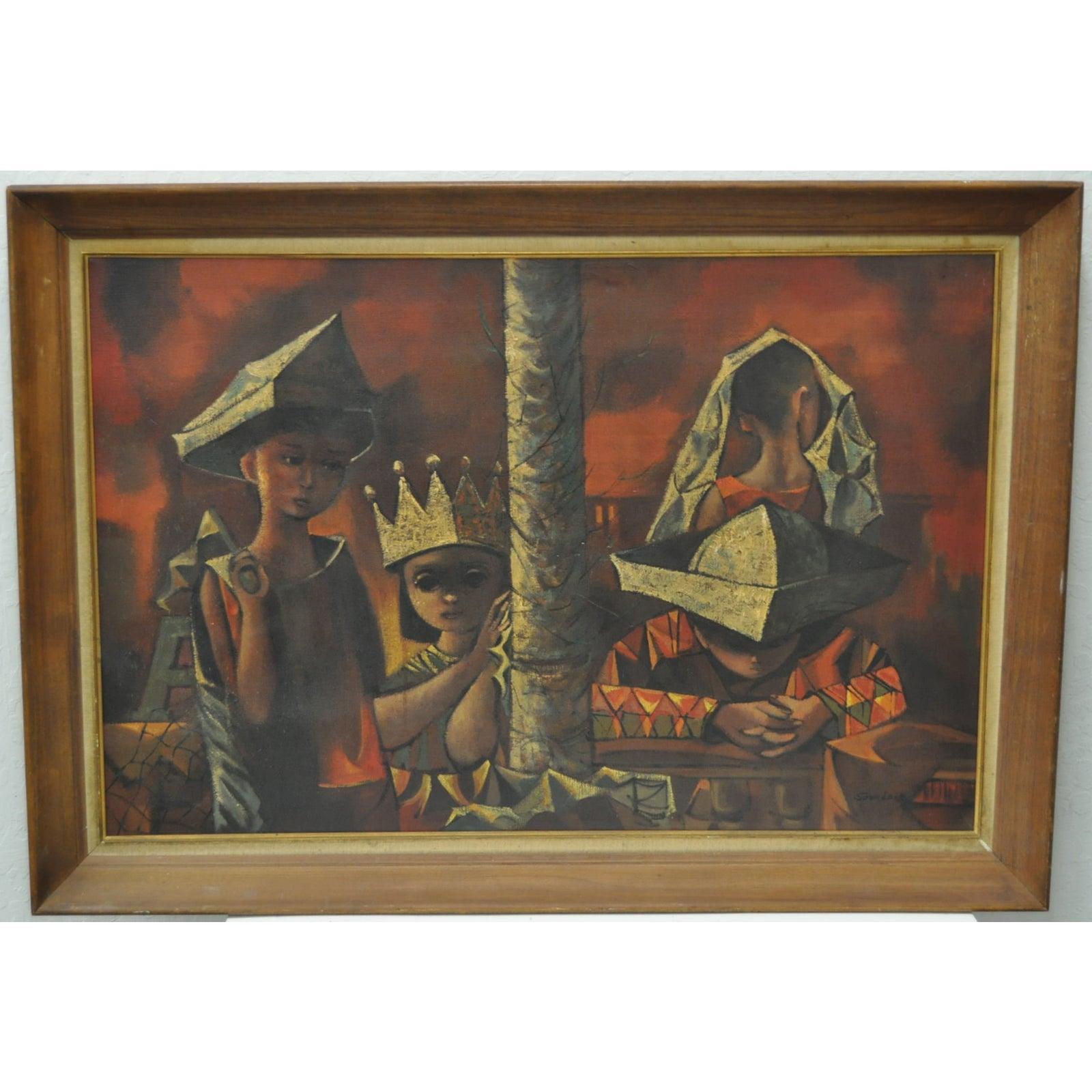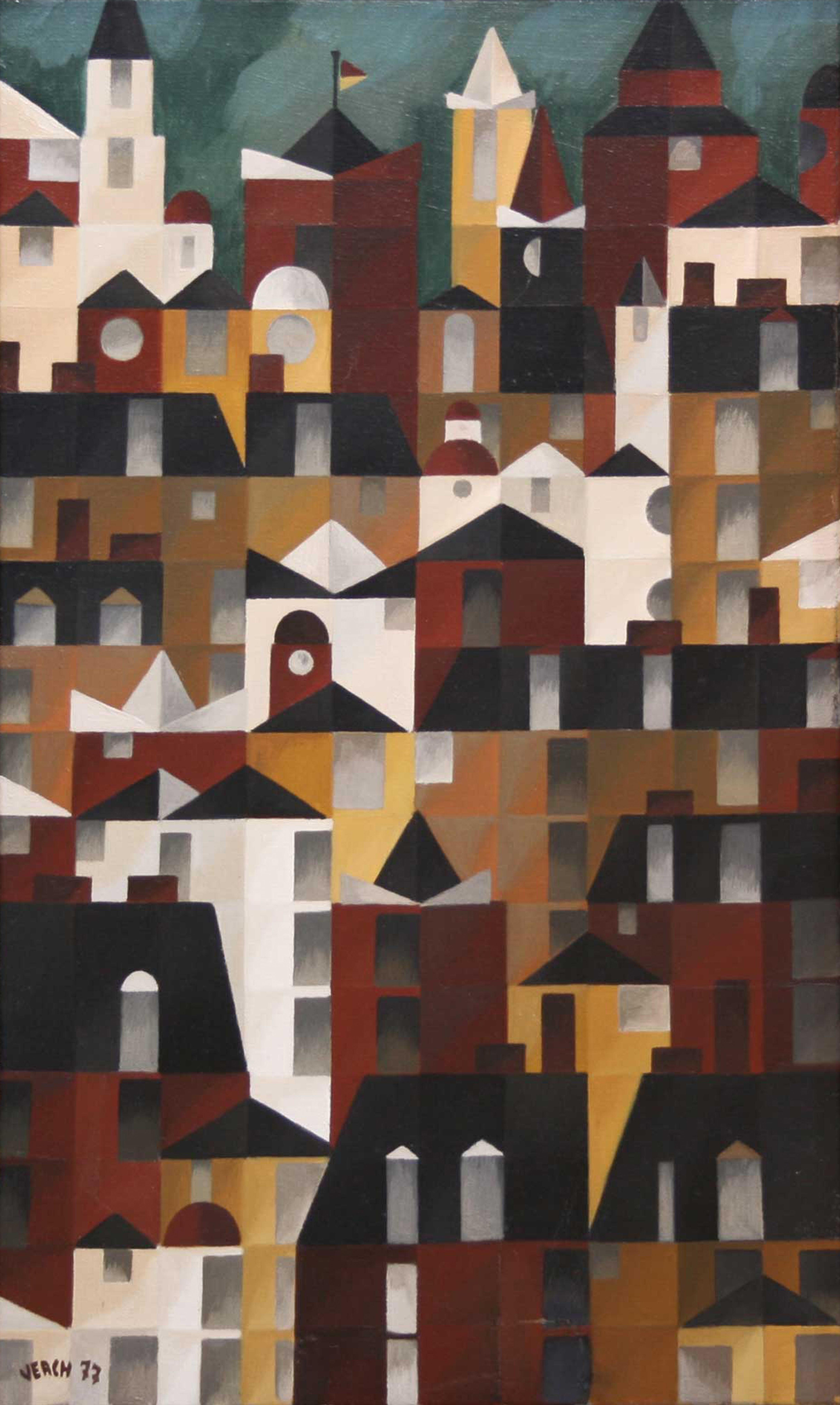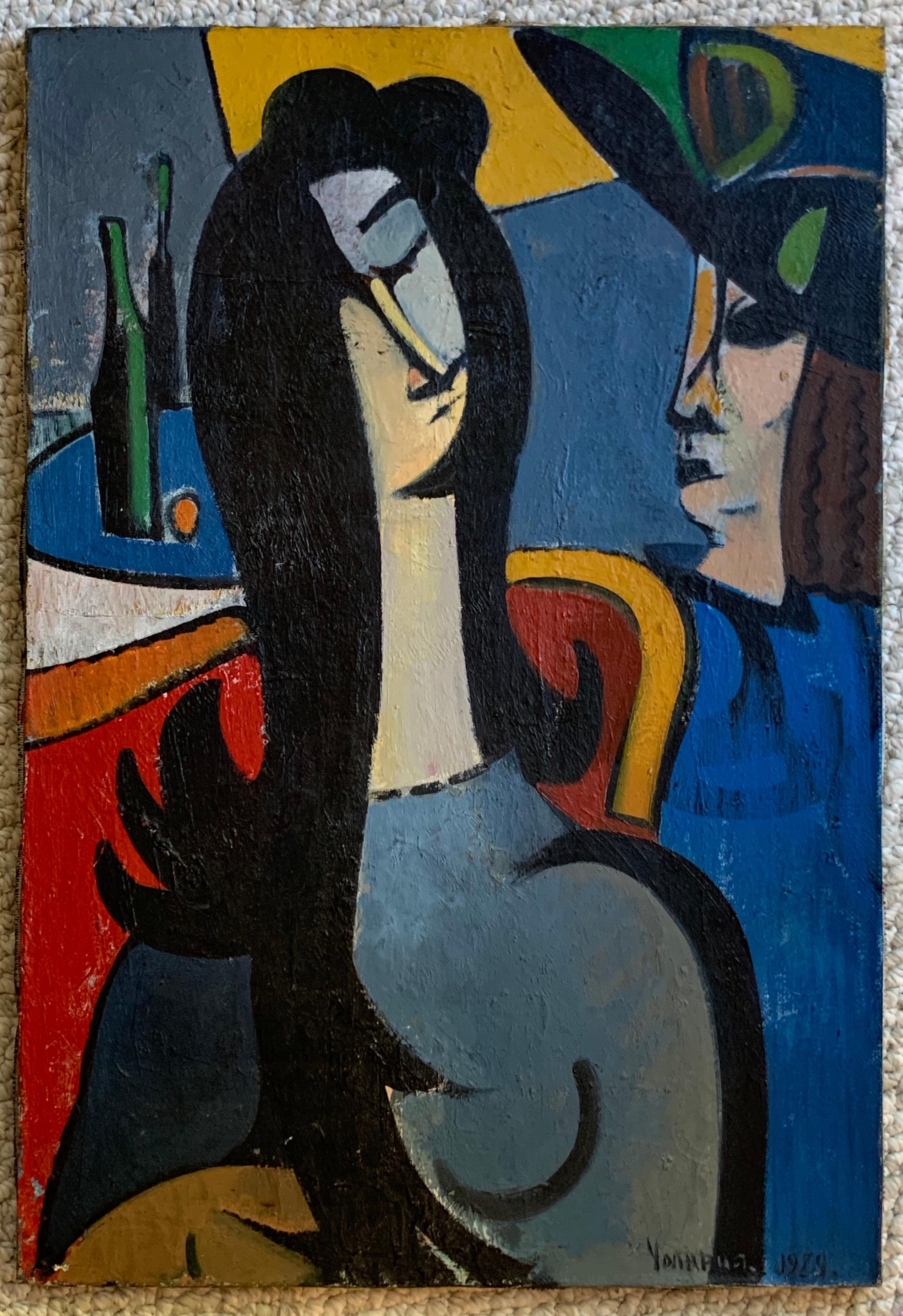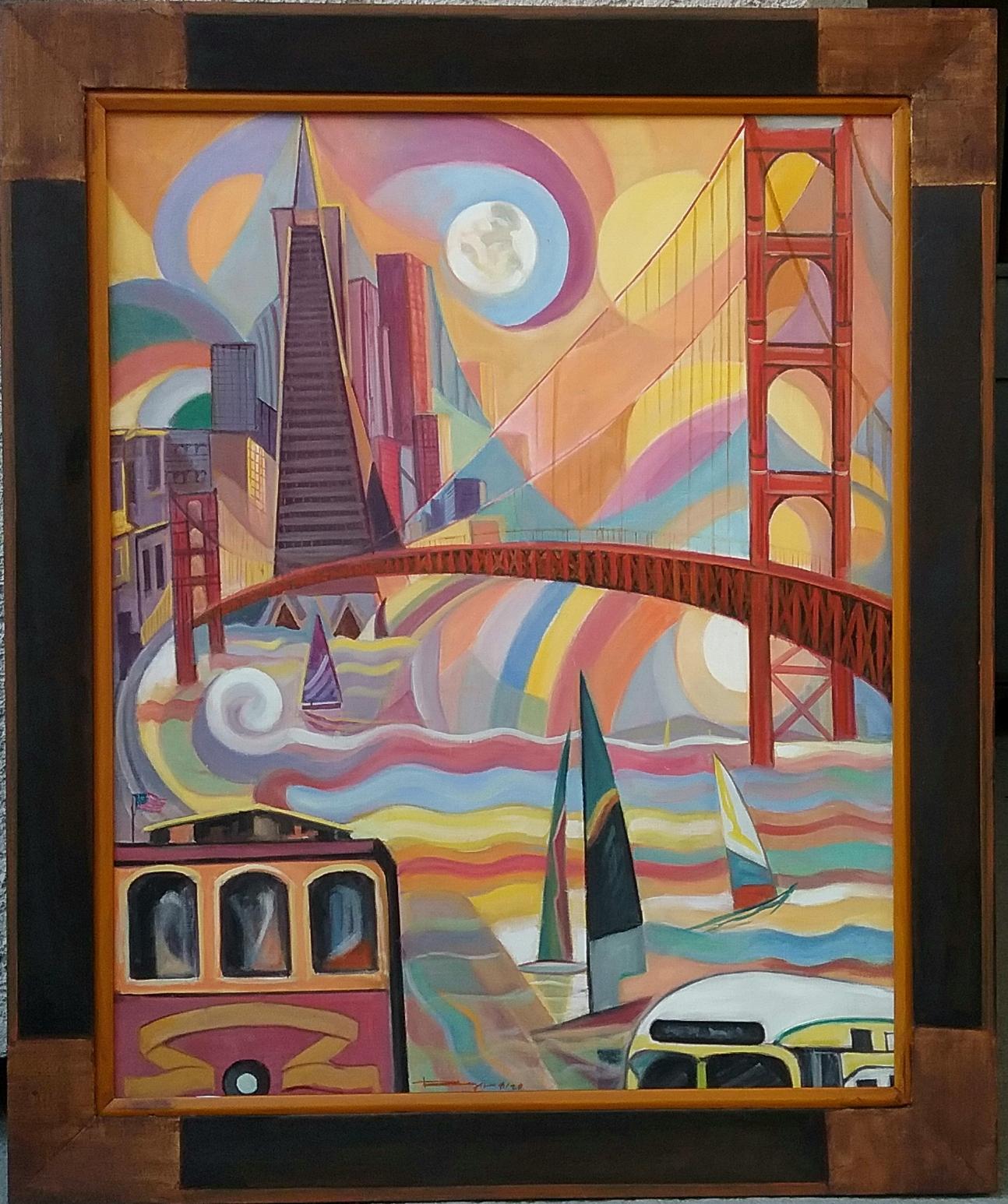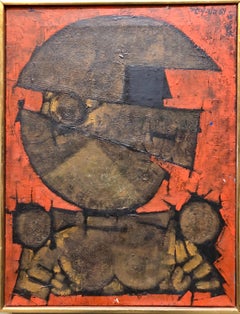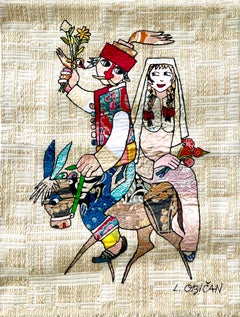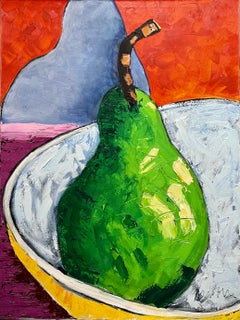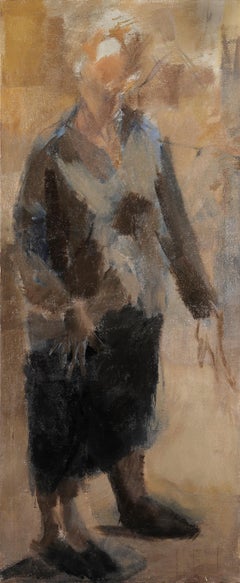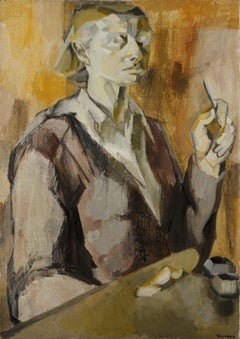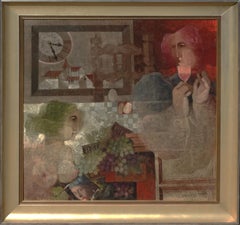
Large Modernist 1960s Israeli Cubist Figures Oil Painting Ruth & Naomi
View Similar Items
Want more images or videos?
Request additional images or videos from the seller
1 of 8
Shaoul SmiraLarge Modernist 1960s Israeli Cubist Figures Oil Painting Ruth & Naomi1962
1962
About the Item
- Creator:Shaoul Smira (1939, Iraqi, Israeli)
- Creation Year:1962
- Dimensions:Height: 46 in (116.84 cm)Width: 26.5 in (67.31 cm)
- Medium:
- Movement & Style:
- Period:
- Condition:slight waviness to canvas.
- Gallery Location:Surfside, FL
- Reference Number:1stDibs: LU3822534373
About the Seller
4.9
Platinum Seller
These expertly vetted sellers are 1stDibs' most experienced sellers and are rated highest by our customers.
Established in 1995
1stDibs seller since 2014
1,546 sales on 1stDibs
Typical response time: 1 hour
More From This SellerView All
- Israeli Cubist Modernist Oil Painting "Rosh Shiryon Abir" ArmorBy Shlomo ZafrirLocated in Surfside, FLShlomo Zafrir is active/lives in Israel, France. Shlomo Zafrir is known for cubist painting. Shlomo Zafrir is a painter and, at the same time, the owner of a nightclub called Omar K...Category
1960s Cubist Abstract Paintings
MaterialsCanvas, Oil
- Naive European French Folk Art Jovan Lazar Obican Tapestry Wall Hanging WeavingLocated in Surfside, FLLazar Obican 1944-2004 Tapestry, mixed media applique on woven background Taking The Bird Away, Folk Art, Dimensions: H 80 cm (32.25 in.) x W 58 cm (23in.) The artist Lazar Obican iconic style is child-like yet masterfully adult; a style that tells a story with sociological overtones. His funny little people are always colorful, full of spirit, living with music and birds to bring them happiness. This is not an aubusson style but a pieced applique, quilt like style on a wool woven background. Mid century modern textile art...Category
Mid-20th Century Folk Art Figurative Paintings
MaterialsOil, Canvas
- Large Pop Art Oil Painting "Pear" Modernist Colorful Composition Suzanne MearsLocated in Surfside, FLBold, colorful, still life oil painting of a pear. In lush, vibrant color. SUZANNE WALLACE MEARS During college she focused on painting and clay. Then it became photography and clay, then only clay, then kiln formed glass and today its kiln formed glass, painting and plasma cut steel sculpture. She also works in oil paint and encaustic. Reminiscent of the color works of Jim DIne and the fruit paintings of Tom Seghi. She never works with only one medium. She uses color and texture to create energetic, luminous, joyous works with the glass. Bright, bold color using reds, blues, oranges reflect my travels in color saturated countries such as Tibet, Nepal, China and Mexico. At random I use solid color fields as a challenge to my driving love of vibrant color. Her favorite themes are inspired by nature and antiquity. Kiln formed glass uses flat sheets of glass which are cut into shapes, layered and incorporate accessory elements of frits, copper wire and mesh, pieces of sheet copper or brass and dichroic glass fired in a kiln. EDUCATION BA, University of Iowa, Iowa City, Iowa, 1964 Graduate School, 44 hours, double major Summer School University of Wisconsin, Madison, Wisconsin 1963 Master Class, Patty Gray Instructor, tde Glass Furnace, Turkey Master Class, Richard La Londe...Category
20th Century Pop Art Abstract Paintings
MaterialsCanvas, Oil
- Whimsical French Folk Art, Naive, Oil Painting Madeline Marie Christine ClavierBy Madeline Christine ClavierLocated in Surfside, FLMADELINE CHRISTINE CLAVIER (1913-2015) Signature: Signed lower right & titled verso Medium: Oil on canvas Provenance: The collection of the artist's family Marie Christine Clavier was born in Saigon, Vietnam in 1913 to French parents and lived there for her formative years. She returned to France as a teenager and began to study painting. Her work quickly developed into whimsical paintings of poetry and songs – harmonized in a unique and distinct painting technique. Her work has an impasto feel and a folk art, outsider artist sensibility to it. Similar in style to Maik and other fantasy realists who use animals, flowers and foliage in their artworks. Marie Clavier painted ro herself rather than for profit as she was quite independently wealthy. She exhibited extensively in the United States in the 1970s especially across Connecticut and New York, showing at various galleries and cultural centres. She had numerous solo exhibitions in the 1970’s- notably at the Maison Francaise in New York and New York University. She showed at Galerie Bernheim Jeune in Paris. She won many awards for her work including Gold Medals and Palme D’Or medals. In 1988 the prestigious art publisher Leopard D’Or produced catalogue book on her life and work – by this point she had virtually given up painting. She died in 2015 aged 102. Bernheim-Jeune gallery is one of the oldest art galleries in Paris. Opened on Rue Laffitte in 1863 by Alexandre Bernheim (1839-1915), friend of Delacroix, Corot and Courbet, it changed location a few times before settling on Avenue Matignon. The gallery promoted realists, Barbizon school paintings and, in 1874, the first impressionist and later post-impressionist painters. It closed in 2019. In 1901, Alexandre Bernheim, with his sons, Josse (1870-1941), and Gaston (1870-1953), organized the first important exhibition of Vincent van Gogh paintings in Paris with the help of art critic Julien Leclercq. In 1906, Bernheim-Jeune frères started presenting works by Pierre Bonnard, Edouard Vuillard, Paul Cezanne, Henri-Edmond Cross, Kees van Dongen, Henri Matisse, Le Douanier Rousseau, Raoul Dufy, Maurice de Vlaminck, Amedeo Modigliani, Maurice Utrillo and Georges Dufrenoy...Category
20th Century Folk Art Animal Paintings
MaterialsCanvas, Oil
- French Mod Surrealist Commedia dell'arte Circus Scene Oil Painting J.P. SerrierBy Jean Pierre SerrierLocated in Surfside, FLJean Pierre Serrier (French, 1934-1989) Oil on canvas painting depicting four figures Hand signed lower right. Measures (frame) 26.5" x 30" wide, and (sight) 18.25." x 22.25" wide. Jean Pierre Serrier (1934 – 1989) was a French painter known for surrealism and absurdist art. Jean-Pierre Serrier was born in Montparnasse, Paris and attended the Académie des Beaux-Arts in Paris. the son of Louis and Solange Serrier. His father fought in World War II and became a prisoner of war. In 1940, as a six-year-old, he and his mother fled Paris for Corrèze in southwest France. Childhood memories of close escapes from German bombardments would later influence his absurdist philosophy of life. Passionate about drawing, in 1951 he applied and was admitted to the École nationale supérieure des arts appliqués et des métiers d'art in Paris. He shared an attic apartment in the 16th arrondissement with fellow student Jean-Baptiste Valadié. For income, he decorated shop windows. A trip to Spain provided motifs for early works. His student work might be characterized as art naïf (Naive art). While still a student, he sold a ceramic artwork to the poet and publisher Pierre Seghers, who would later commission drawings from him. He frequented jazz clubs in Saint-Germain des Près, and while listening to Sidney Bechet at the Vieux Colombier, he met his wife, Yvette.One of the last French Surrealist and follower of Nietzsche. His art conveyed the message to all of mankind that we are only human. The other Surrealist to center his art in philosophy was Rene Magritte whose paintings reflect his understanding of Sigmund Freud. He had his first exhibition in 1955, before being sent to Algeria to complete his military service. After graduating in 1955, he was drafted for military service, spent time in Germany and Morocco, and was sent to the front lines of the Algerian War. In 1959 he exhibited works at two Parisian galleries and at Juan-les-Pins on the Côte d'Azur. From 1961, he exhibited annually at the Salon des Artistes Français. In 1962, the City of Paris purchased his painting Un dimanche In 1961, Serrier made his first visit to the United States to exhibit at a New York gallery. In 1975 and 1979, he had successful exhibitions in New Orleans, and his work was included in art and news magazines, including Time and Newsweek. Beginning in the 1950s, his works included stylized portraits similar in some ways to the "big eyes" art of Margaret Keane, though it is uncertain that either artist influenced the other. Keane painted children, and so did Serrier, sometimes from life, but Serrier’s models are usually somewhat older, though uniformly slender and with androgynous features. A gallery owner introduced Serrier to American collectors Edgar Garbisch and his wife, Bernice Chrysler (daughter of Chrysler founder Walter P. Chrysler), who had a particular interest in naïve art; they commissioned a series of portraits from Serrier. At the same time, he met Reine Ausset in Paris, who in 1961 invited him to New York to take part in an exhibition at Galerie Norval on 57th Street. The show also included work by Moïse Kisling, and the exhibition program explicitly linked the two artists, saying that Serrier, who considered Moise Kisling "the Master," had found his own technique, but "the same vision joins the grand Kisling to the young Serrier: plenitude of shapes, sureness of palette, precision in outlines." In the 1960s he began painting slender, young, androgynous figures in groups, set in sparse landscapes with suggestions of the surreal and sometimes wearing costumes of the Commedia dell'arte. In some of these paintings the eyes of the figures are completely black, a motif that would continue in his later work. In 1965, he exhibited at Forest and Reed Gallery in London. Also in 1965, he discovered the small town of Martel, and with his old roommate Jean-Baptiste Valadié purchased a house that they opened as the gallery La Licorne (The Unicorn) in 1967. Responding to the political upheavals of May 1968 in France, and following the advice of Geneva gallery owner Roger Ferrero, Serrier's work became increasingly complex, idiosyncratic, and surreal. Imagery included the Tower of Babel, bodies suspended in space, and crowds of people all dressed alike, with identical features and entirely black eyes. Mannequins, playing cards, nudes, and levitating orbs also figured in the work. In a nod to Magritte, his men sometimes wear bowler hats. Another influence may have been the works of the Franco-Belgian surrealist Gaston Bogaert (1918-2008). Serrier's first major exhibit of these works, in Geneva in 1971, was titled Le Réalisme Fantastique. (Magic Realism) In 1972, he was made a member of the Société du Salon d'Automne, under whose auspices he was invited by the Polish government to exhibit in Warsaw in 1973, as part of a cultural exchange across the Iron Curtain. In 1976, he served on the jury of the Salon d'Automne. In 1975, New Orleans gallery owner Kurt E. Schon brought his work to several cities in the United States. A copiously illustrated monograph in English, Surrealism and the Absurd: Jean Pierre Serrier, was published in 1977. Author Thomas M. Bayer wrote: Serrier's world is one where—to use Friedrich Nietzche's term—the "human herd animal" is being confronted with the overwhelming task of coping with the world, his solitude, and at times, his resignation in the face of its monstrous size and duration. It is a world where the characterless, "blind" man faces the institutions, rules and symbols that made him into the being he now is…But Serrier does not lose himself in this world he portrays. He never forgets the old French tradition, the "black" humor, à la Molière. This classical humor at times is more felt than seen, in a manner that can be terribly funny, because it is horrifying, laughable, poignant and always true. Serrier told a friend, "In each of my paintings there's a message of hope amid the crowd of stereotypical figures. It could be an escaping dirigible, or a nymphet who flees like a deer under the red and blue trees of paradise...Category
Mid-20th Century Surrealist Figurative Paintings
MaterialsOil, Canvas
- Large Naive European Folk Art Oil Painting Jovan Obican Klezmer Jazz MusicianBy Jovan ObicanLocated in Surfside, FLGenre: Other Subject: People Medium: Oil Surface: Canvas Dimensions: 35" x 16.5 Dimensions w/Frame: 35.5" x 17.25 This depicts a Jazz or Klezmer musician. This one is a banjo or guitar player. The last photo shows it in a group of three that I have available. This listing is for the one painting. The artist Jovan Obican iconic style is child-like yet masterfully adult; a style that tells a story with sociological overtones. His funny little people are always colorful, full of spirit, living with music and birds to bring them happiness. JOVAN OBICAN Cannes, France, b. 1918, d. 1986 Jovan Obican (1918-1986) artist, painter, sculpture and mosaic ceramic artisan was born in Cannes, France, to his Yugoslavian parents. From childhood on, Jovan practically devoted himself to art, scratching designs into the dirt when paper was unavailable. He trained with many recognized teachers and with many styles. He finished his training, imbued with the spirit of his native country, the people, their legends, and their philosophy. It has been said that his work has a "timeless quality" and a naive, folk art, outsider art brut quality, child-like primitive style. Obican is identified with his style the world over, a style that is simple yet sophisticated; child-like yet masterfully adult; a style that tells a story with psychological, philosophical or sociological overtones. His funny little people are always colorful, full of spirit, living with music and birds to bring them happiness. Best known for his depictions of folklore and traditional costumes rendered in a playful, childlike style and for his happy Jewish wedding scenes. He often used bright colors and black outlines in his renderings of figures and animals, giving his work an illustration-like quality. Thematically, the artist’s work is similar to Marc Chagall and Jean Dubuffet for its dreamlike images and so-called naïve style of painting. Over the course of his career, the artist maintained a studio in Boca Raton, Florida and Dubrovnik, Croatia—part of former Yugoslavia— where he developed an interest in Eastern Europe’s Jewish culture. Many of his mature works depict Jewish traditions and ceremonies, including traditional Jewish weddings, the dancing of the Hora, and traditional music. There is a display of his works in his former Dubrovnik studio. His style is a unique conglomerate of tradition, history, legends, heroes, old customs and folklore. It is a self-standing style, recognizable, cheerful, whimsical and a happy creation. Naïve art is any form of visual art that is created by a person who lacks the formal education and training that a professional artist undergoes (in anatomy, art history, technique, perspective, ways of seeing). Unlike folk art, naïve art does not necessarily evince a distinct cultural context or tradition. Naïve art is recognized, and often imitated, for its childlike simplicity and frankness. Paintings of this kind typically have a flat rendering style with a rudimentary expression of perspective. One particularly influential painter of "naïve art" was Henri Rousseau (1844–1910), a French Post-Impressionist who was discovered by Pablo Picasso. Naïve art is often seen as outsider art that is by someone without formal (or little) training or degree. While this was true before the twentieth century, there are now academies for naïve art. Naïve art is now a fully recognized art genre, represented in art galleries worldwide. Museums devoted to naïve art now exist in Kecskemét, Hungary; Riga, Latvia; Jaen, Spain; Rio de Janeiro, Brasil; Vicq France and Paris. "Primitive art" is another term often applied to art by those without formal training, but is historically more often applied to work from certain cultures that have been judged socially or technologically "primitive" by Western academia, such as Native American, sub saharan African or Pacific Island art (see Tribal art). This is distinguished from the self-conscious, "primitive" inspired movement primitivism. Another term related to (but not completely synonymous with) naïve art is folk art. There also exist the terms "naïvism" and "primitivism" which are usually applied to professional painters working in the style of naïve art (like Paul Gauguin, Mikhail Larionov, Paul Klee). At all events, naive art can be regarded as having occupied an "official" position in the annals of twentieth-century art since - at the very latest - the publication of the Der Blaue Reiter, an almanac in 1912. Wassily Kandinsky and Franz Marc, who brought out the almanac, presented 6 reproductions of paintings by le Douanier' Rousseau (Henri Rousseau), comparing them with other pictorial examples. However, most experts agree that the year that naive art was "discovered" was 1885, when the painter Paul Signac became aware of the talents of Henri Rousseau and set about organizing exhibitions of his work in a number of prestigious galleries. The Earth Group (Grupa Zemlja) were Croatian artists, architects and intellectuals active in Zagreb from 1929 to 1935. The group included the painters Krsto Hegedušić, Edo Kovačević, Omer Mujadžić, Kamilo Ružička, Ivan Tabaković, and Oton Postružnik, the sculptors Antun Augustinčić, Frano Kršinić, and the architect Drago Ibler. A term applied to Yugoslav (Croatian) naive painters working in or around the village of Hlebine, near the Hungarian border, from about 1930. Some of the best known naive artists are Dragan Gaži, Ivan Generalić, Josip Generalić, Krsto Hegedušić, Mijo Kovačić, Ivan Lacković-Croata, Franjo Mraz, Ivan Večenaj and Mirko Virius. Camille Bombois (1883–1970) Ferdinand Cheval, known as 'le facteur Cheval' (1836–1924) Henry Darger (1892–1973) L. S. Lowry (1887–1976) Grandma Moses, Anna Mary Robertson (1860–1961) Nikifor (1895–1968) Poland, Horace Pippin (1888–1946) Jon Serl (1894-1993) United States Alfred Wallis (1855–1942) Scottie Wilson (1890–1972) Gesner Abelard (b. 1922) Jan Balet (1913–2009) Michel Delacroix (b. 1933) France Howard Finster (1916–2001) Ivan Rabuzin (1921–2008) Spontaneous Art Museum in Brussels Art en Marge Museum in Brussels MADmusée in Liege International Museum of Naive Art of Brazil...Category
20th Century Folk Art Figurative Paintings
MaterialsCanvas, Oil
You May Also Like
- Portrait of the artist's motherBy Élisabeth Dujarric de La RivièreLocated in BELEYMAS, FRElisabeth DUJARRIC de LA RIVIÈRE (Jouy-en-Josas 1930 – Excideuil 2005) Portrait of the artist's mother Oil on canvas H. 171 cm; L. 70 cm Signed on the back Provenance: Private collection, Périgord Born in the heart of the Bièvre valley, a few kilometers from Versailles...Category
1950s Cubist Portrait Paintings
MaterialsCanvas, Oil
- Elisabeth Dujarric de la Rivière (1930-2005) Self-portrait with paletteBy Élisabeth Dujarric de La RivièreLocated in BELEYMAS, FRElisabeth DUJARRIC de LA RIVIÈRE (Jouy-en-Josas 1930 - Excideuil 2005) Self-portrait with apple Oil on canvas H. 100 cm ; L. 73 cm Sig...Category
1950s Cubist Portrait Paintings
MaterialsCanvas, Oil
- "Horas de Rodigio", Alvar Sunol, Original, Oil/Canvas, 39x39, Modern CubistBy Alvar Sunol Munoz-RamosLocated in Dallas, TX"Horas de Rodigio" by Alvar Sunol is an Original Oil on Board painting and measures 39x39. This painting incorporates Alvar's favorites drawing inspiration of mixing the old with the...Category
2010s Cubist Interior Paintings
MaterialsCanvas, Oil
- Boats. 1980. Canvas, oil, 70x70 cmLocated in Riga, LVBoats. 1980. Canvas, oil, 70x70 cm Contrasting landscape with boats in cubistic style in red and yellow tonesCategory
1980s Cubist Landscape Paintings
MaterialsCanvas, Oil
- SpiritBy William Y. CooperLocated in Buffalo, NY"Spirit" a bold and thoughtful cubist oil on canvas was painted in December of 2001 by African American artist William (Bill) Cooper. William Y. Cooper was a writer, painter, muralist, illustrator, and art teacher. He moved to Western New York in 1954 from Birmingham, Alabama, to pursue work, and Buffalo has been his home ever since. In 1975, he received his Bachelor of Fine Arts degree from the University at Buffalo; he was also a state certified art teacher. Cooper woked primarily in oils and acrylics, but also creates drawings on paper. He has painted several commissioned murals and has had more than fifteen one-man shows in Western New York and Ghana, West Africa, and has participated in more than twenty-five group exhibitions since he began his professional career in 1969. His paintings and drawings address both his African heritage and his experience as an American through symbolism and metaphor. He observes, “I am an Afrocentric artist. My worldview is rooted in an African frame of reference and a deep, abiding sense of the creator from whence I draw my inspiration, strength, and a sense of who I am. The use of symbols allows me to explore literal ideas.” Among Cooper’s published works are two children’s books, 77 Jackson Street, Rear and Nakai and the Red Shoes, and a novel for adults, The Mopane Tree. Cooper founded the Afrocentric Artists’ Collective and ran the organization from 1979 to 1981. In 2013 he was designated a “Living Legacy” artist by the Burchfield Penney Arts Center, the latest in a series of honors which has also included awards from the Arts Council of Buffalo & Erie County, the New York State Council on the Arts, and Alpha Kappa Alpha...Category
21st Century and Contemporary Cubist Abstract Paintings
MaterialsCanvas, Oil
$4,000 Sale Price38% Off - Mid Century Modern Cubist Painting w/ Figures of Children by Spurlock c.1950Located in San Francisco, CAMid century modern figural abstract painting with a touch of cubism. Original oil on canvas. Dimensions 35 1/2" x 23 1/2". Frame dimensions 41" x 29". Very good vintage conditi...Category
Mid-20th Century Cubist Figurative Paintings
MaterialsCanvas, Oil
